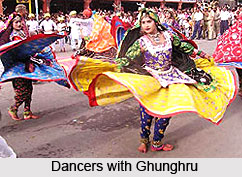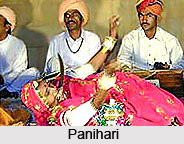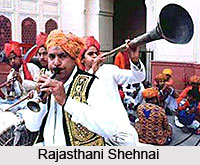 The Rajasthani folk music has a long tradition and it is a mixture of different flavors. There are folk songs dedicated to religious customs, festivals, fairs and deities. There are popular folk songs or folk idioms by saints like Kabirdas, Surdas and Meerabai. Let us study the music styles in detail:
The Rajasthani folk music has a long tradition and it is a mixture of different flavors. There are folk songs dedicated to religious customs, festivals, fairs and deities. There are popular folk songs or folk idioms by saints like Kabirdas, Surdas and Meerabai. Let us study the music styles in detail:
Maand: This is the most popular Rajasthani folk music that had developed in the royal courts and the local musicians play it. Traditional instruments are played by the musicians and the folk singers sing the glory and praise of the Rajput rulers like like Tejaji, Gogaji and Ramdeoji.
Panihari: This folk music is sung by women and the theme of most of these songs are based on the scarcity of water and their daily chores of the village women near the village well. Some of these panihari folk songs are based on chance encounters with lovers and some are based on the relations in between mother-in-laws and daughter-in-laws.
Bhajans: This music combines both royal heritage and divinity of Lord Krishna in a perfect blend, since the various Krishna bhajans have been penned down by Mirabai, herself. These immensely popular songs have formed a new school of music and have reached to every Krishna lovers of the world.
The folk arts and music traditions of Rajasthan, North India are kept alive by local entertainers such as the Dholis, Langas, Mirasis and Manganniyars. The folk musicians are apt in classical tradition. Songs normally began with an alap, which set the tune of the song and then recital of the couplet that is called the dooba. The songs also have the taan, the pitch and the tibias -the triplet, which lends variance to the tune. The accompanying instruments are of various varieties to repercussion, string and wind and even common use utilities like bells, thali (metal dishes) and earthen pots. Thus, the typical musical instruments played in the Rajasthani music are as follows:
 Shehnai: Shehnai is widely played in Rajasthan, at the time of marriages and festivals. It consist of a single piece wooden tube with a number of holes, and at the top it has a metal mouthpiece, through which a it can be played.
Shehnai: Shehnai is widely played in Rajasthan, at the time of marriages and festivals. It consist of a single piece wooden tube with a number of holes, and at the top it has a metal mouthpiece, through which a it can be played.
Morchang: Morchang is a wrought iron instrument, like the Jews harp, which produces twanging sounds. It is the most favourite instrument for Langa community of Rajasthan. This instrument produces a variety of notes and weaving a large range of rhythmic patterns.
Khartal: Khartal is a devotional instrument, which is used at the time of religious singing. It consists of a pair of flat rectangular wooden clappers, having thin brass jingles attached to it. It is played by attaching a ringed into a thumb, whereas the other parts are held by the remaining four fingers, which, when clapped against each other, produce a enchanting sound.
Chang: This instrument is used as a rhythmic accompaniment to the erotic songs and dances on the colourful occasion of Holi festival. It has sheep skin pasted on a large circular or octagonal wooden frame, which is balanced on the right shoulder. It is played with the help of both the hands, left striking the rim and right the central part.

Ghunghru: It is a very notable instrument for musical embellishment. A bunch of them threaded in a cotton string and tied round the ankles of the dancers, which on dancing produce bewitching tinkling sounds to the rhythm at each step of the performer. Most of the royal kings in Rajasthan used to enjoy the charm of dancing with the rhythm of Ghunghrus.
Manjeera: Manjeera is a pair of concave cymbals, cast in an alloy of brass, copper and zinc and connected to each other with a cotton cord passing through the holes in their centre. An interesting use of the instrument is made by the performers of the teratali, when as many as thirteen cymbals are used.
Kamayacha: It has a large circular belly covered with parchment, a peg system and a finger board. It has three main strings of gut, besides which, nine supplementary and other four sympathetic steel strings are placed, passing through a broad bridge. The long wooden curved bow of horse-tail hair moving on all the strings is characteristic of this unique Rajasthani instrument. Used by all singing communities, specially in Marwar but mainly by those belonging to the Langas.
Bankia: Bankia is a trumpet like brass instrument with an oblong loop type tube body, which has a saucer shaped opening and it is an integrated mouthpiece through which, an air is blown powerfully. Although played with number of instruments, it is best heard with the dhol. Playing Bankia is a unique instrument, which is generally used to strengthen the overall effect of the celebration.
Dhol: The Dhol is a double sided barrel drum, which is played mostly at the time of marriages and festivals seasons. The playing of Dhol is an important instrument, according to the tradition of royal Rajasthan. The rope of the Dhol is usually placed over the neck of the drum player, whereas the surface of the wooden barrel of Dhol is sometimes decorated with engraved or painted patterns.
Nagara: Nagara is one of the most oldest instrument, used since the royal times. In those times it was used for announcing major declarations and decisions from the royal families. It is capable of producing a variety of rhythms, deep and thunderous, to give company to massive community dances like raasmandal and ghoomar.
Ravanhatta: It consists of half a coconut shell resonator covered with membrane, bound to it with the help of cotton cords, a two feet long bamboo stick fixed to the resonator with two main strings, one of horse tail and other of steel. In addition to these are sympathetic steel strings varying between three to thirteen, passing over a bridge and than directly to the wooden pegs fixed to the sides of the stick. It is played with a curved bow of horse tail hair drawn across the strings with rhythmic jerks, the small brass bells attached to it providing the jingling stress on the beats. It is held by the left hand, the resonator resting on the left side of the chest.




















